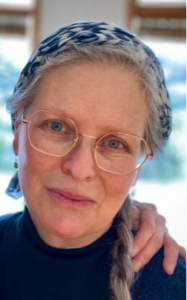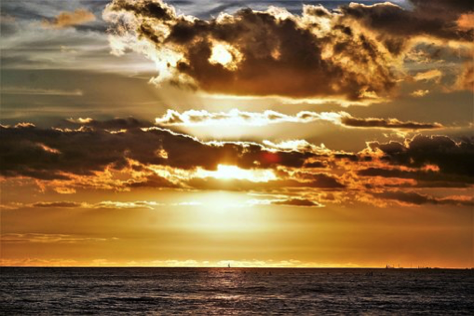The River of Mystical Hope

The nature of the wellspring is to spring forth.
– Cynthia Bourgeault, Mystical Hope
When I was small, I would sit in silent conversation with the river. Those were the days when a six- or seven-year-old could do such things: step out of the house unnoticed and alone to ponder the elements. I allowed the Columbia River to sweep me up into itself. Before me danced the  ever-present Tin Cup Rapids, a tiny part of the greater expanse. It was a patch of rough, skipping water that seemed never to change, save for an occasional unruly splash or sparkle that captured my attention.
ever-present Tin Cup Rapids, a tiny part of the greater expanse. It was a patch of rough, skipping water that seemed never to change, save for an occasional unruly splash or sparkle that captured my attention.
From time to time, I expanded my view from that narrow stretch of whitewater to discover that the river expanded too. Sometimes my childhood self could perceive how the river’s force subsumed my own little portion into a much vaster, ever-moving whole. From the familiar and particular before me, I could sense the river in its roiling, multifaceted unity, forever in motion and yet somehow making its way toward a vibrant place of rest.
Back home (if I remembered, if I listened) I continued to sense that transformative motion. Whatever I was doing, that river flowed. On and on it went, changing and staying the same, whether I was playing, sleeping, going to school, or arguing with my sisters. Through every season, through every trouble and joy. Despite me, the river flowed.
Just like mystical hope.
At the book’s beginning, Cynthia Bourgeault describes how mystical hope differs from an ordinary kind of hope. Mystical hope is not something that hinges on clambering aspiration and starry-eyed dreams, but is instead a way of being in relationship here and now with “a light-force that radiates objectively.” [i]
Yet, in chapter five, Cynthia complicates things by adding a paradox: while situated in the present, mystical hope simultaneously orients itself toward the future and divine culmination. It holds equally through an interweaving of times, the enfolding of what has been, what is, and what is yet to come, the collective passage toward “fulfillment in love” (MH 80).
 Coursing through all times, mystical hope is not much like our common conception of linear time shouldering things aside in its pursuit of progress. How then can a river, moving as it does in one direction, be for me like the multivalent mystical hope? The directness of the river’s path may indeed nudge our ideas of time, change, and being toward sequential, linear models rather than a wholeness derived from unimaginably complex interconnectedness.
Coursing through all times, mystical hope is not much like our common conception of linear time shouldering things aside in its pursuit of progress. How then can a river, moving as it does in one direction, be for me like the multivalent mystical hope? The directness of the river’s path may indeed nudge our ideas of time, change, and being toward sequential, linear models rather than a wholeness derived from unimaginably complex interconnectedness.
 Let’s think then on what makes the river: the rush of water here before us, the ceaseless flow, and especially, the whole great water cycle, with its many phases both within and beyond our perception. Its towering clouds, bubbling springs, and shining glaciers. Its hidden groundwater, meandering oxbows, and creeping marshlands. Its mist, dew, hail, frost. All these elements continually work together to prompt a river’s flow.
Let’s think then on what makes the river: the rush of water here before us, the ceaseless flow, and especially, the whole great water cycle, with its many phases both within and beyond our perception. Its towering clouds, bubbling springs, and shining glaciers. Its hidden groundwater, meandering oxbows, and creeping marshlands. Its mist, dew, hail, frost. All these elements continually work together to prompt a river’s flow.
The river is not a straight arrow that beelines from source to delta, but a phase of the water cycle, a loop in constant motion that coexists with its end point: the sea, which gathers all to itself.
 Certain details of European culture and history make it hard to imagine time being like the water cycle. The idea of a timeline that moves in one direction and sifts out unwanted things is a particularly strong vestige of European Enlightenment thought and nineteenth-century social evolutionary theory. It is based on the errant idea that history is marching through set stages and will inevitably arrive at European-style civilization, not to mention its preferred modes of perception. Rather than incorporating the richness and value of a diverse world, these ideas see change as narrowly progressing toward an apex styled from the European imperial imagination. The unilineal timeline is an enduring relic of colonial history created from a particular culture’s own venerated self-image.[ii]
Certain details of European culture and history make it hard to imagine time being like the water cycle. The idea of a timeline that moves in one direction and sifts out unwanted things is a particularly strong vestige of European Enlightenment thought and nineteenth-century social evolutionary theory. It is based on the errant idea that history is marching through set stages and will inevitably arrive at European-style civilization, not to mention its preferred modes of perception. Rather than incorporating the richness and value of a diverse world, these ideas see change as narrowly progressing toward an apex styled from the European imperial imagination. The unilineal timeline is an enduring relic of colonial history created from a particular culture’s own venerated self-image.[ii]
 Like the conceptual turn from Newtonian theories to quantum physics, our models of time, change, and adaptation have also shifted. We now understand better that the temporal river is nonlinear, flexible, and inclusive; it brings us through time not by jettisoning pieces of ourselves until we are whittled down to a culturally imagined ideal. Mystical hope instead carries all of our aspects – our perceived failures and weaknesses, as well as our perceived strengths and achievements – to form a greater whole through radical inclusivity.
Like the conceptual turn from Newtonian theories to quantum physics, our models of time, change, and adaptation have also shifted. We now understand better that the temporal river is nonlinear, flexible, and inclusive; it brings us through time not by jettisoning pieces of ourselves until we are whittled down to a culturally imagined ideal. Mystical hope instead carries all of our aspects – our perceived failures and weaknesses, as well as our perceived strengths and achievements – to form a greater whole through radical inclusivity.
In a recent blog of teachings on the work of Jean Gebser, Cynthia Bourgeault says that none of the parts “replace one another or cancel out each other’s unique identity. Rather, they complement and deepen one another, like interwoven threads in an unfolding tapestry.” [iii]
 If any part of the water cycle fails, the whole fails. All aspects are essential, even the parts we reject. Everything contributes to the ceaseless flow.
If any part of the water cycle fails, the whole fails. All aspects are essential, even the parts we reject. Everything contributes to the ceaseless flow.
Our engagement with mystical hope contributes something crucial to the ceaseless turn of the great waterwheel. Through our surrender to the divine wellspring, we can infuse a transformative quality of aliveness into the cycle. Says Cynthia, mystical hope is “entered always and only through surrender. And yet when we enter in, it enters us and fills us with its own life – a quiet strength beyond anything we’ve ever known” (MH 87). If we surrender to the aliveness that is deeper than our individual will or moral stance, our strength and capacity grows for right action in the world. The willingness to surrender to mystical hope engenders a vibrancy everywhere around us.
Back on the riverbank, back through time, a child is ignited by wonder. She senses the inherent flow of hope. We too can take our place among the granite boulders and surrender to the unfolding river. We can ponder how the river is many things and one thing, and how water in all its phases generates living vibrancy and powers our journey to the sea.
[i] Valentin Tomberg in Mystical Hope, p. 77.
[ii] More than a hundred years of comparative research in anthropology and history, as well as the newer discipline of critical race theory, show how the theories of unilineal evolutionism, or Social Darwinism, has no basis in fact. See some foundational studies, like Franz Boas’s Race, Language, and Culture (1940) and Eric Wolf’s ironically titled, Europe and the People without History (1982).
[iii] Cynthia Bourgeault’s recent teachings on the structures of consciousness, based on Jean Gebser’s The Ever-Present Origin (1997), offers greater complexity on how humanity changes toward a deepening integral consciousness that draws on all pieces, rather than the sequential, exclusionary models of consciousness on which much Christian evolutionary theory is based. For an overview, see Jeremy Johnson’s Seeing Through the World (2019), as well as Cynthia’s “Exploring Gebser” blog series on Wisdom Waypoints (the first lesson is at: Stages Versus Structures: Exploring Jean Gebser, Lesson I – Wisdom Waypoints).
 Paula Pryce is a cultural anthropologist and writer who specializes in the study of ritual, performance, embodied knowledge, and contemplative religions. She is the author of The Monk’s Cell: Ritual and Knowledge in American Contemplative Christianity (Oxford University Press, 2018).
Paula Pryce is a cultural anthropologist and writer who specializes in the study of ritual, performance, embodied knowledge, and contemplative religions. She is the author of The Monk’s Cell: Ritual and Knowledge in American Contemplative Christianity (Oxford University Press, 2018).
Mystical Hope – Wisdom Book Circle Series (2022)
The following are part of our monthly series of reflections and resources from the friends and leaders of the Wisdom Waypoints Wisdom Book Circles exploring: Mystical Hope: Trusting in the Mercy of God by Cynthia Bourgeault.



Absolutely beautiful. Your inspiration fills my heart. Thank you. Blessings.
Anna
Thank you, Anna. A blessed Advent to you.
Thank you for the insights and well written reflection on Chapter Five. I was taken by the idea of, “The unilineal timeline is an enduring relic of colonial history created from a particular culture’s own venerated self-image.” I look forward to tomorrow’s discussion and deeply appreciate the learning in Chapter Five.
Thank you for all your thoughtful contributions, Helen. We were enriched by your presence in the book circle.